DEATH OF OSAMA BIN LADEN
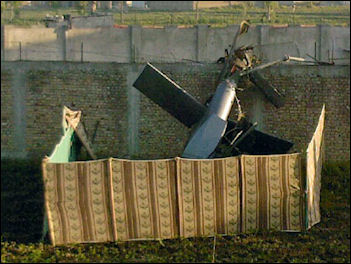
crashed stealth copter
In May 2011, Osama bin Laden was killed in his hideout in Pakistan by U.S. forces. "Justice has been done," U.S. President Barack Obama declared as crowds formed outside the White House to celebrate. Many sang "The Star-Spangled Banner" and "We Are the Champions."
Reuters reported: “Bin Laden, 54, was killed by Navy SEALs and CIA paramilitary forces at a compound in the city of Abbottabad. He was shot in the left eye. Initially U.S. officials suggested that Bin Laden opened fire on the American forces before he was killed but later it was revealed he was unarmed. [Source: Reuters, MSNBC.com, May 2, 2011]
The special operations forces were on the ground for less than 40 minutes and the operation was watched in real-time by Obama, U.S. Secretary of State Hillary Clinton, U.S. Vice President Joe Biden and the national security team at the White House. CIA Director Leon Panetta and his team watched events as they unfolded at the CIA headquarters. The CIA director said neither he nor Obama saw bin Laden shot.
Five people were killed in the raid, officials said: Bin Laden; his son; his most trusted courier, Abu Ahmed al-Kuwaiti, and al-Kuwaiti's wife and brother. Initially White House officials incorrectly said bin Laden's wife died in gunfire while serving as his human shield. The woman that was killed was actually bin Laden's aide's wife, and she was just caught in cross fire, the White House said. Al Arabiya TV reported that two of bin Laden's wives and four of his children were captured during the operation.
Book: “Manhunt: The Ten-Year Search for Bin Laden — from 9/11 to Abbottabad” by Peter L. Bergen (Crown, 2012).
Mission to Kill Osama bin Laden
Obama tapped two dozen members of the Navy's elite SEAL Team Six to carry out the raid.The target of the mission — Osama bin Laden — was code-named Geronimo. When the SEALs on the ground said: "Geronimo EKIA" — enemy killed in action — it was a message that bin Laden was dead.

Obama watching the raid Adam Goldman and Matt Apuzzo of Associated Press wrote: “Before dawn... helicopters left Jalalabad in eastern Afghanistan. The choppers entered Pakistani airspace using sophisticated technology intended to evade that country's radar systems, a U.S. official said. Officially, it was a kill-or-capture mission, since the U.S. doesn't kill unarmed people trying to surrender. But it was clear from the beginning that whoever was behind those walls had no intention of surrendering, two U.S. officials said. [Source: Adam Goldman and Matt Apuzzo, Associated Press, May 3, 2011]
“The helicopters lowered into the compound, dropping the SEALs behind the walls. No shots were fired, but shortly after the team hit the ground, one of the helicopters came crashing down and rolled onto its side for reasons the government has yet to explain. None of the SEALs was injured, however, and the mission continued uninterrupted.
Reuters reported: “With officials at the CIA and the White House watching on television monitors, tensions increased when one of the two Black Hawk helicopters lowered into the compound and, beneath a moonless sky, fell heavily to the ground. Officials believe that was due to higher-than-expected air temperature that interfered with the chopper's ability to hover — an aeronautical condition known as "hot and high." [Source: Reuters, MSNBC.com, May 2, 2011]
AP reported: “The SEALs all got out of the downed helicopter and proceeded into the compound. As they swept through the property, they handcuffed those they encountered with plastic zip ties and pressed on in pursuit of their target. Many SEAL team members carry helmet-mounted cameras, but the video beamed back to Washington did not show the fateful showdown with bin Laden, officials said.
“Thanks to sophisticated satellite monitoring, U.S. forces knew they'd likely find bin Laden's family on the second and third floors of one of the buildings on the property, officials said. The SEALs secured the rest of the property first, then proceeded to the room where bin Laden was hiding. A firefight ensued, Brennan said. Ahmed and his brother were killed, officials said. Then, the SEALs killed bin Laden with a bullet just above his left eye, blowing off part his skull, another official said. Using the call sign for his visual identification, one of the soldiers communicated that "Geronimo" had been killed in action, according to a U.S. official.
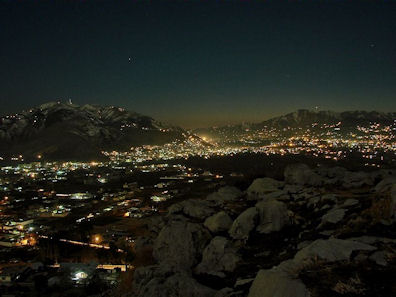
Abbottabad at night Reuters reported: “Intelligence officials weren't certain that bin Laden would be at the site as there was "no smoking gun that put him there," NBC News reported. But Bin Laden was indeed holed up in a two-story house 100 yards from a Pakistani military academy when four helicopters carrying U.S. forces swooped in. [Source: Reuters, MSNBC.com, May 2, 2011]
Sixteen people were taken into custody by Pakistani forces: three of bin Laden’s wives, who were living with him in the compound, and 13 children, eight of them bin Laden’s. Nahal Toosi and Zarar Khan of Associated Press reported: “After killing the terror leader, his son and two others, they doubled back to move nine women and 23 children away from the compound, according to U.S. officials. Those survivors of the raid are now "in safe hands and being looked after in accordance to the law," the Pakistani government said in a statement.[Source: Nahal Toosi and Zarar Khan, Associated Press, May 3, 2011]
Julie Watson of Associated Press wrote: The CIA's makeshift command center erupted in applause as the SEALs helicoptered to safety... Sunday's raid was nearly textbook perfect, and officials say its participants will likely receive some of the military's highest medals. As military personnel, they are not eligible for the $25 million reward that was offered for hunting down bin Laden. [Source: Julie Watson, Associated Press, May 3, 2011]
Eyewitness Accounts of the Mission to Kill Osama bin Laden
"After midnight, a large number of commandos encircled the compound. Three helicopters were hovering overhead. All of a sudden there was firing toward the helicopters from the ground," Nasir Khan, a resident of the town, told Reuters. "There was intense firing and then I saw one of the helicopters crash," said Khan, who had watched the dramatic scene unfold from his rooftop.
The sound of at least two explosions rocked Abbottabad as the fighting raged. Resident Sahibzada Salahuddin said he was asleep when explosions woke him. "I was sleeping when all of a sudden there was a blast. It was followed by two more small blasts ... I opened the door and saw the entire compound was on fire," he said.[Source: Reuters, MSNBC.com, May 2, 2011]
Greg Miller wrote Washington Post two weeks after the raid: When a team of two dozen commandos arrived at the site Monday, one of bin Laden’s couriers was the only enemy to open fire, officials said. “They had to blow through some doors and walls,” said the U.S. official briefed on the raid. “One door they opened up only to find a [cement] wall behind it.” The SEALs encountered no other armed opposition as they ascended to the top floor, where bin Laden was found. “He was in the doorway and then retreated, and that’s where the operators moved in,” the senior U.S. official said. [Source: Greg Miller, Washington Post , May 17, 2011]
The chopper that "inexplicably" stopped working during the operation was later destroyed by the U.S. team. Nahal Toosi and Zarar Khan of Associated Press reported: Neighbors showed off small parts of what appeared to be a U.S. helicopter that malfunctioned and was disabled by the American strike team as it retreated. A small servant's room outside the perimeter showed signs of violent entry and a brisk search. Clothes and bedding had been tossed aside. A wall clock was on the floor, the time stuck at 2:20.” [Source: Nahal Toosi and Zarar Khan, Associated Press, May 3, 2011]
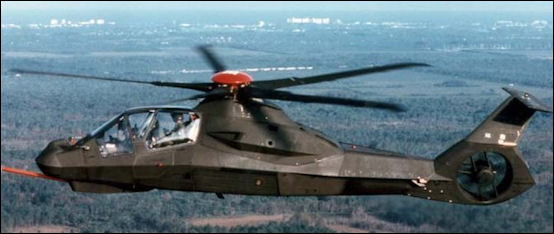
Apache Stealth Helicoper
Osama bin Laden Unarmed When SEALs Stormed Room
Speaking on the condition of anonymity, a senior U.S. security official told Reuters that Navy SEALs dropped by helicopter to the compound were under orders to not capture bin Laden. "This was a kill operation," the official said.
Matt Apuzzo and Adam Goldman of Associated Press wrote: “Osama bin Laden was unarmed when Navy SEALs burst into his room and shot him to death, the White House said two days after the raid, a change in the official account that raised questions about whether the U.S. ever planned to capture the terrorist leader alive. Asked about the final confrontation with bin Laden, Panetta said: "I don't think he had a lot of time to say anything." The CIA chief told PBS NewsHour, "It was a firefight going up that compound. ... I think it - this was all split-second action on the part of the SEALs." [Source: Matt Apuzzo and Adam Goldman, Associated Press, May 3, 2011]
Panetta said that bin Laden made "some threatening moves that were made that clearly represented a clear threat to our guys. And that's the reason they fired." Panetta said that Obama had given permission to kill the terror leader: "The authority here was to kill bin Laden," he said. "And obviously, under the rules of engagement, if he had in fact thrown up his hands, surrendered and didn't appear to be representing any kind of threat, then they were to capture him. But they had full authority to kill him." Obama's chief counterterrorism adviser, John Brennan, said: "If we had the opportunity to take bin Laden alive, if he didn't present any threat, the individuals involved were able and prepared to do that."
Greg Miller wrote Washington Post two weeks after the raid: “Bin Laden was first spotted by U.S. forces in the doorway of his room on the compound’s third floor. Bin Laden then turned and retreated into the room before being shot twice — in the head and in the chest. U.S. commandos later found an AK-47 and a pistol in the room. “He was retreating,” a move that was regarded as resistance, a U.S. official briefed on the operation said. “You don’t know why he’s retreating, what he’s doing when he goes back in there. Is he getting a weapon? Does he have a [suicide] vest?” [Source: Greg Miller, Washington Post , May 17, 2011]
Seal Team Six, the Group That Carried the Mission
The operation that killed Osama bin Laden was carried out by more than 20 U.S. Navy SEALS in an elite special forces group unofficially called Seal Team 6. Robert Johnson wrote in Business Insider, “Officially, the team's name is classified and not available to the public, technically there is no team 6. A Tier-One counter-terrorism force similar to the Army's elusive Delta group, Team 6's mission rarely make it to paper much less the newspaper. [Source: Robert Johnson, Business Insider, May 02, 2011]
“The members of Team 6 are all "black" operatives. They exist outside military protocol, engage in operations that are at the highest level of classification and often outside the boundaries of international law. To maintain plausible deniability in case they are caught, records of black operations are rarely, if ever, kept. The development of SEAL Team 6 was in direct response to the 1980 attempt to rescue the American hostages held in Iran. The mission was a terrific failure that fell apart at many points and illustrated the need for a dedicated counter-terrorist team capable of operating with the utmost secrecy.

bin Laden compound
“The Team was labeled 6 at the time to confuse Soviet intelligence about the number of SEAL teams in operation at the time. There were only two others. Team 6 poached the top operatives from other SEAL units and trained them even more intensely from there. Even among proven SEALs the attrition rate for Team 6 is reported to be nearly half.There are no names available for current Team 6 members, but the CIA does recruit heavily from their numbers for their Special Operations Group, so it makes sense that they were chosen to work with the CIA on this mission.
“Team 6 is normally devoted to missions with maritime authority: ship rescues, oil rigs, naval bases or land bases accessible by water. There are no waterways near Bin Laden's compound. When a former Navy SEAL was called for a comment about this article all he could say was: "You know I'd love to help you man, but I can't say a word about Team 6. There is no Team 6."
Ken Dilanian wrote in the Los Angeles Times: “The Navy SEALs who killed Bin Laden swept into Pakistan on nearly silent, secret stealth helicopters. The assault team had practiced in Afghanistan on a full-scale mock-up of the maze-like compound. From satellite photos, they knew where the occupants hung their laundry and burned their trash. Spies at a nearby safe house had helped count the women and children inside. CIA analysts knew a tall man strode the dirt courtyard, but the suspect they dubbed "the Pacer" never left the prison-like walls. [Source: Ken Dilanian, Los Angeles Times, May 8, 2011]
AFP reported: “Meeting a few days later with the SEALs who carried out the raid, Obama gave the pilot of the crashed helicopter "a pretty good hug." "They presented me with the flag that had gone on that mission, signed by all of them on the back, and I think it's fair to say that will probably be the most important possession that I leave with from this presidency," he said. [Source: AFP, May 2, 2012]
About three weeks after the raid Obama met behind closed doors at the CIA with about 60 intelligence officers from different agencies who had been closely involved in the effort to track down bin Laden. "You're often the first ones to get the blame when things go wrong and you're always the last ones to get the credit when things go right," Obama said. "Most of you will never get headlines for what you do; you won't get ticker tape parades. You have the thanks of a grateful nation." [Source: Patricia Zengerle, Reuters. May 20, 2011]
Stealth Helicopter and War Dog
Greg Miller wrote in the Washington Post: “The operation in Abbottabad involved... U.S. aircraft with stealth features, a Black Hawk helicopter equipped with special cladding to dampen noise and evade detection during the 90-minute flight from a base in Afghanistan. The helicopter was intentionally destroyed by U.S. forces — leaving only a tail section intact — after a crash landing at the outset of the raid. The assault and the months of surveillance leading up to it involved venturing into some of Pakistan’s most sensitive terrain. Because of the compound’s location — near military and nuclear facilities — it was surrounded by Pakistani radar and other systems that could have detected encroachment by Predators or other non-stealth surveillance planes, according to U.S. officials. [Source: Greg Miller, Washington Post , May 17, 2011]
ABC News reported: “Before an elite team of U.S. Navy SEALs executed a daring raid that took down Osama bin Laden, the commandos were able to silently sneak up on their elusive target thanks to what aviation analysts said were top secret, never-before-seen stealth-modified helicopters. In the course of the operation that cost the al Qaeda leader his life, one of the two Blackhawk helicopters that carried the SEALs into bin Laden's Pakistani compound grazed one of the compound's wall and was forced to make a hard landing. With the chopper inoperable, at the end of the mission the SEALs destroyed it with explosives. [Source: Brian Ross, Rhonda Schwartz, Lee Ferran and Avni Patel, ABC News, May 4, 2011]
But photos of what survived the explosion — the tail section of the craft with curious modifications — has sent military analysts buzzing about a stealth helicopter program that was only rumored to exist. From a modified tail boom to a noise reducing covering on the rear rotors and a special high-tech material similar to that used in stealth fighters, former Department of Defense official and vice president of the Lexington Institute Dan Goure said the bird is like nothing he's ever seen before. "This is a first," he said. "You wouldn't know that it was coming right at you. And that's what's important, because these are coming in fast and low, and if they aren't sounding like they're coming right at you, you might not even react until it's too late... That was clearly part of the success."
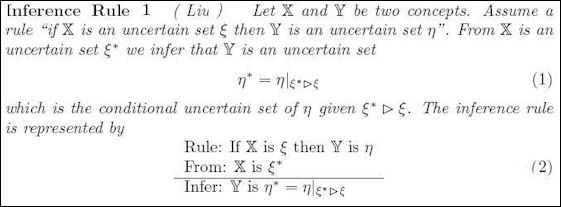
Uncertain inference
In addition to the noise-reducing modifications, a former special operations aviator told The Army Times the general shape of what was left of the craft — the harsh angles and flat surfaces more common to stealth jets — was further evidence it was a modified variant of the Blackhawk. A senior Pentagon official told ABC News the Defense Department would "absolutely not" comment on anything relating to the destroyed bird.
Neighbors of bin Laden in Abbottabad, Pakistan, told ABC News they didn't hear the helicopters the night of the Sunday raid until they were directly overhead. The rotor covering, along with a special rotor design, suppressed the choppers noise while inbound, Bill Sweetman, editor and chief of Defense Technology International, said. "Helicopters make a very distinctive percussive rotor sound which is caused by their rotor blades and if you can blend that down, of course that makes a noise that is much less likely to be heard and much more likely to blend into any background noise that there is," Sweetman said.
The U.S. has attempted to use stealth helicopters before. In the mid-90s, the Army developed several prototypes of the Comanche helicopter, a reconnaissance helicopter that was at the time a revolutionary step in stealth technology. But in 2004 the Department of Defense scrapped the program and promised to use the technology developed for the Comanche on other crafts. Since, the government has been working to silence the Army's Blackhawk helicopters but an official program for the stealth choppers was never publicized. The wreckage, Sweetman said, is the first the public has ever seen of an operational stealth-modified helicopter.
"We probably have been running hundreds of missions with these helicopters over the last half dozen years, and the fact is, they've all been successful — or at least the helicopters have all come back," he said. But now that one went down and photographs emerged of large sections being taken from the crash site under a tarp, former White House counterterrorism advisor and ABC News consultant Richard Clarke said U.S. officials may have reason to worry about where those parts end up. "There are probably people in the Pentagon tonight who are very concerned that pieces of the helicopter may be, even now, on their way to China, because we know that China is trying to make stealth aircraft," he said. The Chinese military is known to have a close relationship with the Pakistani military.
The Navy SEALs also brought along Cairo, a German Shepherd dog tasked with tracking anyone who tried to escape from bin Laden's compound and alerting the special operations forces to anyone approaching. [Source: AP, May 24, 2011]
Preparations and Doubts About the Success of the Mission to Kill Osama bin Laden
Stephen Collinson of AFP wrote: In March 2011, “Obama was sufficiently confident about the intelligence on the compound that he ordered the military to develop plans to attack it. "We know there is a compound, we know some of the individuals there, we know they are associated with bin Laden, they live under extremely unique circumstances," the official said. "If you build the case, it clearly leads to the fact that there is somebody who is a high value terrorist there, and bin Laden is the only person that fits the profile of who that high value terrorist would be." [Source: Stephen Collinson, AFP, May 2, 2011]
“By April, Obama was presented with three options: inserting a US team to capture or kill the suspect, launching some kind of surgical strike like a bombing raid, or waiting for the development of further intelligence.Amid intense secrecy, unusual even for the White House, Obama deliberated on what path to take with a small corps of top officials.The downside of a bombing run was that, while it would not risk US personnel, it could cause more civilian casualties, and would leave little evidence as to the identity of those killed, the official said. "It is not that you couldn't prove it wasn't him — you wouldn't know for sure," that you had hit bin Laden, the senior official said. The option to send special forces in by helicopter would preserve the possibility of obtaining evidence — but would risk soldiers and had a higher chance of angering Pakistan with flights over its territory.

United States Security Codewords
Matt Apuzzo and Adam Goldman of Associated Press wrote: Though Monday's pre-dawn raid on that compound was a major counterterrorism victory, there had been no guarantee of success. Government analysts suspected bin Laden was living there but could never prove it. Satellite surveillance provided the military with images to plan its strike but never captured a picture of bin Laden on the property. [Source: Matt Apuzzo and Adam Goldman, Associated Press, May 3, 2011]
With no assurance that bin Laden would be there, sending troops into Pakistan was a risky call. The SEALs could storm a compound and find no terrorists at all, leaving Pakistan furious about a U.S. military incursion. Or the Pakistani military, not realizing what was going on, could send its own air force to attack the SEAL team. "What if you go down and you're in a firefight and the Pakistanis show up and start firing?" Panetta said in an interview with Time. "How do you fight your way out?"
Obama, Clinton and Others Watch the Mission to Kill Osama bin Laden
AP reported: “From halfway around the world, President Barack Obama and his national security team monitored the strike on Osama bin Laden’s compound in real time, watching and listening to the firefight that killed the terrorist leader. Gathered in the White House Situation Room, members of the group held their breath and barely spoke as they waited to see whether a carefully crafted yet extremely risky plan would succeed, said White House counterterrorism adviser John Brennan. Mr.Obama had been playing golf but returned to the White House for the suspenseful watch. [Source: AP, May 4, 2011]
As the SEALs lowered themselves from helicopters into bin Laden’s compound in Abbottabad, Pakistan, the President and his advisers could only wait. “It was probably one of the most anxiety-filled periods of time, I think, in the lives of the people who were assembled here,” Mr. Brennan told reporters. “The minutes passed like days, and the president was very concerned about the security of our personnel.”
There hadn’t been unanimity among members of Mr. Obama’s team about going forward with the plan. The president had plenty of evidence to suggest bin Laden would be found in the compound” as indeed he was — but there was no ironclad certainty he was there. Then there was the danger. Anything could happen. And indeed, something did. One of the helicopters carrying the SEALs stalled upon arrival in the compound and had to be abandoned. It was a heart-stopping moment.
“Seeing that helicopter in a place and in the condition that it wasn’t supposed to be, I think that was one of — at least for me and I know for the other people in the room — was the concern we had that now we’re having to go to the contingency plan,” said Mr. Brennan. The contingency plan of switching to a different chopper worked. In the end, so did the whole operation, and bin Laden was shot dead. But not before the president’s nerves got a serious workout.
“When we finally were informed that those individuals who were able to go in that compound and found an individual that they believed was bin Laden, there was a tremendous sigh of relief,” said Mr. Brennan. “And the president was relieved once we had our people and those remains off target.”
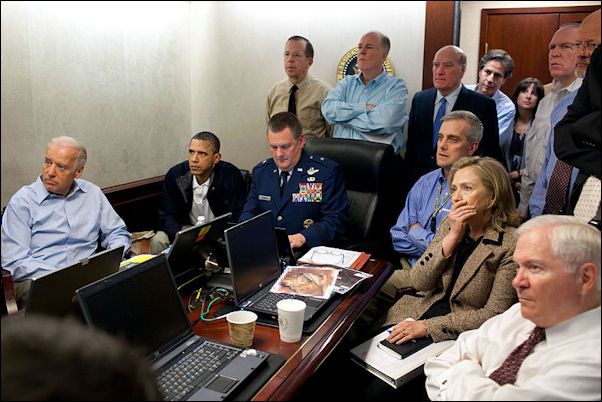
watching the raid
Greg Miller wrote in the Washington Post: Stealth drones were used on the night of the raid, providing imagery that President Obama and members of his national security team appear in photographs to have been watching as U.S. Navy SEALs descended on the compound shortly after 1 a.m. in Pakistan. The drones are also equipped to eavesdrop on electronic transmissions, enabling U.S. officials to monitor the Pakistani response. [Source: Greg Miller, Washington Post, May 17, 2011]
Obama on the Mission to Kill Osama bin Laden
David Remnick wrote in The New Yorker: At around nine-forty-five that Sunday evening, as we were finishing the dishes or putting the kids to bed, the bulletins began: a tumble of cyber-hints and obscure details, televised requests to stay tuned for important news — and then, just after eleven-thirty, President Obama striding into the East Room of the White House to inform the country that “justice has been done,” that Special Operations forces had just hours earlier completed a “targeted operation” to kill bin Laden...The most stirring aspect of Obama’s speech announcing bin Laden’s death was its sobriety, its refusal of “Mission Accomplished” theatrics. [Source: David Remnick, The New Yorker, May 16, 2011]
About a week after the mission Obama expressed his thoughts and feelings about it in an interview on CBS's "60 Minutes." Asked whether he did not warn the Pakistani government or the military, or even the Pakistani intelligence community, of the impending raid, because he did not trust them, Obama replied: "I didn't tell most people here in the White House. I didn't tell my own family. It was that important for us to maintain operational security. If I'm not revealing to some of my closest aides what we're doing, then I sure as heck am not going to be revealing it to folks who I don't know." [Source: Donna Smith and Zeeshan Haider, Reuters, May 8, 2011]
Obama said he agonized over the decision to go ahead with the mission for fear of the loss of American life and because it was inside sovereign Pakistan. "And so if it turns out that it's a wealthy, you know, prince from Dubai who's in this compound and, you know, we've sent special forces in — we've got problems," he said. But he added: "The one thing I didn't lose sleep over was the possibility of taking bin Laden out. Justice was done. And I think that anyone who would question that the perpetrator of mass murder on American soil — didn't deserve what he got needs to have their head examined." Pakistan's government has "indicated they have a profound interest in finding out what kinds of support networks bin Laden might have had," Obama said. "But ... it's going to take some time for us to be able to exploit the intelligence that we were able to gather on site."
A year after the raid Obama said that the killing of Osama bin Laden was "the most important single day" of his time in the White House — and the daring Navy SEAL raid that ended the al-Qaida chief's life was "the longest 40 minutes of my life." "I did choose the risk," Obama said in an interview with NBC News' Brian Williams. "The reason I was willing to make that decision of sending in our SEALs to try to capture or kill bin Laden rather than to take some other options was ultimately because I had 100 percent faith in the Navy SEALs themselves." [Source: AFP, May 2, 2012]
Obama emphasized that plans for the raid — dubbed "Operation Neptune's Spear" — had to be a closely guarded secret to avoid tipping off bin Laden — code-named "Geronimo." "Even a breath of this in the press could have chased bin Laden away," Obama said. "We didn't know at that point whether there might be underground tunnels coming out of that compound that would allow him to escape." Huddled in the White House's high-tech Situation Room, Obama and his top national security aides watched the first part of the raid and gasped when one of the helicopters carrying the elite commandos crashed over the compound's stone wall.
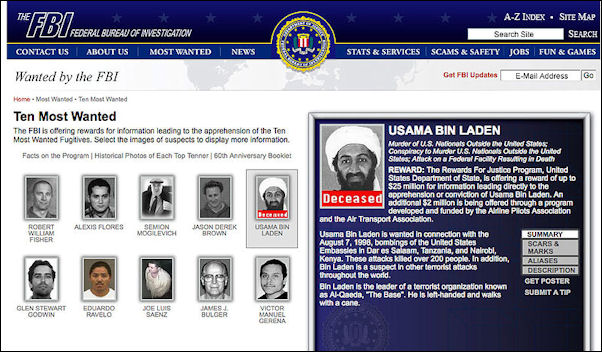
"That helicopter didn't make it to the right spot and everyone went, like, 'Whoa,'" Vice President Joe Biden told NBC. "The only thing that I was thinking about throughout this entire enterprise was, 'I really want to get those guys back home safe,'" said Obama. "I want to make sure that the decision I've made has not resulted in them putting their lives at risk in vain, and if I got that part of it right, if I could look myself in the mirror and say as commander in chief I made a good call."
It was never contentious because I think everybody understood both the pros and cons of the action,” Obama said. “People who were advocating action understood that if this did not work, if we proved to be wrong, there would be severe geopolitical consequences and obviously most importantly, we might be putting our brave Navy SEALs in danger.”During the meeting, the president never indicated which way he was leaning. After the discussion, he dismissed his team and said he’d have a decision in the morning. He had dinner with his family and then went to his study after his wife and daughters went to bed. “Well, there is no doubt that you don't sleep as much that evening as you do on a normal night,” the president said. “I stayed up late and I woke up early.”
Legal Questions over Bin Laden Killing
Andrew Longstreth of Reuters wrote: “International law experts in the United States said important legal questions remained about the killing of Osama bin Laden even as the Obama administration defended the action. While an act of Congress a week after the September 11 attacks gave the U.S. president broad powers to act against terrorism, the legality of the commando killing of the al Qaeda leader is less clear under international law, some experts said. The killing raised concerns elsewhere that the United States may have gone too far in acting as policeman, judge and executioner of the world's most wanted man. [Source: Andrew Longstreth, Reuters, May 5, 2011]
"It's a complicated question as a legal matter," Steven Ratner, a professor at the University of Michigan Law School, told Reuters. "A lot of it depends on whether you believe Osama bin Laden is a combatant in a war or a suspect in a mass murder." Under the theory that the government is at war against al Qaeda — which the Obama administration has adopted — one could argue that the killing of bin Laden was legal. "Whether he has a gun or not really doesn't matter," said Ratner. "You're lawfully permitted to kill combatants."
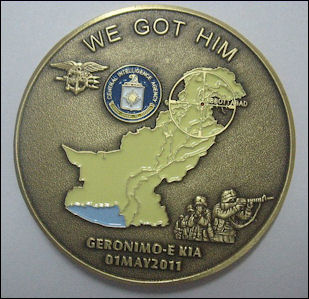
CIA's "We Got Him" Challenge coin
produced by Minnichs Metals Attorney General Eric Holder, the country's top law enforcement officer, told a U.S. Senate committee that the operation was legal. "He was the head of al Qaeda, an organization that had conducted the attacks of September the 11th," Holder said. "It's lawful to target an enemy commander in the field. We did so, for instance, with regard to Yamamoto in World War Two, when he was shot down in an airplane." Former Attorney General Alberto Gonzales, who served in the Bush administration, said the analysis should end there. "He was a military target," Gonzales told Reuters. "We're in a conflict — there's no question about that. I'm not sure what the debate is about."Gonzales added that whether bin Laden was armed or not was irrelevant. "Suppose we fired a missile," said Gonzales. "Would we be asking the question if he was armed or not?"
The legal analysis of a U.S. operation is different if bin Laden is considered a mass murder suspect, Ratner said. "If you're operating in that framework, you would only be able to kill a suspect if they represented an immediate threat to you," he added.Complicating the picture is that bin Laden was indicted in Manhattan U.S. District Court in 1998 for conspiracy to attack U.S. defense installations, said David Scheffer, director for the Center for International Human Rights at the Northwestern University School of Law. "Normally when an individual is under indictment the purpose is to capture that person in order to bring him to court to try him," Scheffer said. "The object is not to literally summarily execute him if he's under indictment."
Ratner and Scheffer said key questions remained about the operation, such as what instructions the Navy SEALs who carried out the mission were given and what efforts bin Laden had made to surrender. Scheffer said if the Navy SEALs were ordered to kill bin Laden without trying first to capture him, it may have violated American ideals if not international law. "It seems to me that with the character of our society, it might have been more consistent with American values to have at least ordered his capture with rules of engagement," he said. [Source: Andrew Longstreth, Reuters, May 5, 2011]
Osama Bin Laden’s Corpse and Burial at Sea
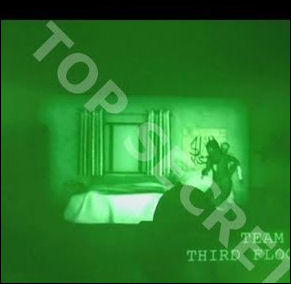
doctored image snatched from Internet
allegedly taken inside bin Laden
compound during raid After the mission in Pakistan the SEAL team returned to Afghanistan with bin Laden's body, which was later buried at sea. U.S. officials have said facial recognition software and DNA testing prove the body was bin Laden's. U.S. official s said there was only 1 in 11.8 quadrillion chance of mistaken identity. Bin Laden’s DNA sample was compared with a “comprehensive profile derived from bin Laden’s large, extended family.”
Adam Goldman and Matt Apuzzo of Associated Press: “Bin Laden's body was immediately identifiable, but the U.S. also conducted DNA testing that identified him with near 100 percent certainty, senior administration officials said. Photo analysis by the CIA, confirmation on site by a woman believed to be bin Laden's wife, who was wounded, and matching physical features such as bin Laden's height all helped confirm the identification. At the White House, there was no doubt. [Source: Adam Goldman and Matt Apuzzo, Associated Press, May 3, 2011]
"The burial of Bin Laden's remains was done in strict conformance with Islamist precepts and practices," said John Brennan, US President Barack Obama's top counter-terrorism adviser. Islamic tradition calls for a body to be buried within 24 hours, but finding a country willing to accept the remains of the world's most wanted terrorist would have been difficult, a senior administration official said. There are reports that Bin Laden’s native Saudi Arabia refused to permit his burial on its soil, thus requiring a sea burial.
“Bin Laden's body was flown to the USS Carl Vinson in the North Arabian sea, a senior defense official said. There, aboard a U.S. warship, officials conducted a traditional Islamic burial ritual. Bin Laden's body was washed and placed in a white sheet. The preparations took about an hour. He was placed in a weighted bag that, after religious remarks by a military officer, was slipped into the sea about 2 a.m.
Phil Stewart of Reuters wrote: “At the funeral service, his shrouded body was placed in a weighted bag and eased into the north Arabian Sea. Religious remarks were translated into Arabic and read aloud, the U.S. military said. U.S. officials have offered various reasons for the at-sea burial, including the need to bury him within 24 hours according to Islamic custom. Others have said it would prevent bin Laden's grave from becoming a shrine. [Source: Phil Stewart, Reuters May 3, 2011]
Images of Osama bin Laden’s Body
![]()
doctored image snatched from Internet President Barack Obama decided not to release photos of bin Laden's body, which were deemed too gruesome to reveal. "It's wrong to say that I did a high-five" when he first saw them, Obama said. "You have a picture of a dead body and, you know, there's I think regardless of who it is, you always have to be sober about death. But understanding the satisfaction for the American people, what it would mean for 9/11 families, what it would mean for the children of folks who died in the twin towers who never got to know their parents, I think there was a deep-seated satisfaction for the country at that moment," he said. [Source: AFP, May 2, 2012]
There were concerns that the photographs could offend Muslims and be exploited by extremists.U.S. Defense Secretary Robert Gates said that one reason he opposed releasing photographs of Osama bin Laden corpse was that he was he was worried they might be altered in some way to provoke a backlash. CIA director Leon Panetta seemed to suggest the possibility of releasing the images when he told NBC: "The bottom line is that, you know, we got bin Laden and I think we have to reveal to the rest of the world the fact that we were able to get him and kill him.” Senate Intelligence Committee Chairwoman Dianne Feinstein acknowledged some value in releasing images to provide proof that bin Laden was dead. But at the same time, she said: "I just don't see a need to do it," pointing to the DNA evidence.
AP reported: Senator James Inhofe, a Republican from Oklahoma, said he was shown 15 photographs taken of bin Laden after he was killed in a US commando raid on May 2. In an interview with CNN, Inhofe agreed that the photos taken immediately in the compound in Pakistan immediately after bin Laden was killed were "pretty gruesome". "One of the shots went through an ear and out through the eye socket. Or it went in through the eye socket and out — then exploded," he said. "That caused the brains to hang out of the eye socket, so that was pretty gruesome." [Source: AP, May 12, 2011]
Three photos were taken after bin Laden's body was removed from the compound and flown to a US aircraft carrier in the Arabian Sea, Inhoffe said. They show the body being washed and prepared for burial according to Muslim rites, and then lowered into the sea, he said. "They had taken enough blood and material off his face so it was easier to identify who it was," Inhofe said."Then of course the burial at sea, had the transition — first of all, identifying who it was. Then of course the fact that they buried him at sea," he said.
Inhofe said he had no doubt the man was bin Laden. "Absolutely, no question about it. I've seen them. That was him. He's gone. He's history," he said. At least some of the photos show bin Laden's face, or what remained of it after he was shot twice by a Navy SEAL commando. One of the bullets hit the 54-year-old bin Laden above the left eye and the other entered his chest. In April 2012, AP reported: “The world may never see photographic proof of his death. U.S. District Judge James E. Boasberg in Washington ruled last week that the Obama administration, under the Freedom of Information Act, would not have to turn over images of bin Laden during or after the raid. "Verbal descriptions of the death and burial of Osama Bin Laden will have to suffice," Boasberg wrote in his ruling on the lawsuit by the public interest group Judicial Watch. [Source: Kimberly Dozier, Associated Press, April 30, 2012]
Conspiracy Theories and Reaction to Osama bin Laden 's Death

Some Muslim clerics questioned whether the United States properly followed Islamic tradition, saying Muslims should not be buried at sea unless they died during a voyage. A prominent Egyptian imam in Egypt, Ahmed El-Tayeb, said the U.S. violated Islamic custom by not burying bin Laden on land, a move seen as a US attempt to prevent his resting place from becoming a shrine for his followers. Omar bin Laden, bin Laden’s forth eldest son, denounced the killing of bin Laden as “criminal” and said his burial at sea was humiliating. According to the SITE Intelligence Group Omar bin Laden said the bin Laden children may take legal action against the United States in international court to “determine the true fate of our vanished father.” The comments were made in a letter published on the website of Islamist Abu Walid al-Masri. [Source: Adam Goldman and Matt Apuzzo, Associated Press, May 3, 2011]
Fatih Abdulsalam wrote in Iraq's Azzaman: “Was the news of Bin Laden's burial at sea meant to provoke hundreds of millions of Muslims who are still divided on Osama Bin Laden?” [The Americans] said they were compelled to do so because there was no country willing to receive his body. This is a pretext as there is no evidence that Washington had contacted all the countries in the world to see whether they would accept to provide a proper burial for him”. Everything was done in accordance with the American way that is characterized with blunders and stupidity.”
The Afghan Taliban initially called reports of bin Laden's death "premature," saying the United States had not provided sufficient evidence he was killed. Many Taliban believe bin Laden is still alive. Taliban commander Mullah Dadullah said in interview with British television , “He’s not yet martyred.” [Source: complied by Emal Haidary, Los Angeles Times, May 8, 2011]
Alex Rodriguez wrote in the Los Angeles Times: “It was all a ruse, Ejaz Ahmad sniffed. Osama bin Laden never lived in Abbottabad. To Ahmad, the secret night raid by U.S. commandos, the staccato bursts of gunfire, the crash of the stealth helicopter and the reported killing of the Al Qaeda leader in a whitewashed compound just down the road were pure theater. The Americans made it all up to convince the world that terrorism exists everywhere in Pakistan. "Then they'll come in and take control of our nuclear weapons," the 20-year-old college student said as he walked along a dirt path near the compound. In Abbottabad and across the country, many Pakistanis remain unconvinced that Bin Laden was killed in a raid May 2. A poll conducted by international market research firm YouGov found that two-thirds of Pakistanis do not believe Bin Laden was killed last month by a team of U.S. Navy SEALs. Some people say either that Bin Laden died several years ago or that he's still alive, waiting for the right time to reappear in public. [Source: Alex Rodriguez, Los Angeles Times, May 31, 2011]
Image Sources: Wikimedia Commons except Time cover Time and wrecked copter ABC News
Text Sources: New York Times, Washington Post, Los Angeles Times, Times of London, The Guardian, National Geographic, The New Yorker, Time, Newsweek, Reuters, AP, AFP, Wall Street Journal, The Atlantic Monthly, The Economist, Global Viewpoint (Christian Science Monitor), Foreign Policy, Wikipedia, BBC, CNN, NBC News, Fox News and various books and other publications.
Last updated July 2012
